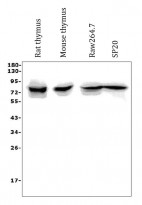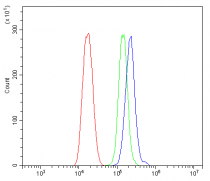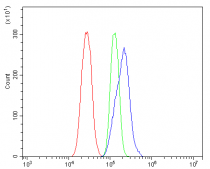ARG43137
anti-RANK antibody
anti-RANK antibody for Flow cytometry,Western blot and Mouse,Rat
Overview
| Product Description | Rabbit Polyclonal antibody recognizes RANK |
|---|---|
| Tested Reactivity | Ms, Rat |
| Tested Application | FACS, WB |
| Host | Rabbit |
| Clonality | Polyclonal |
| Isotype | IgG |
| Target Name | RANK |
| Antigen Species | Mouse |
| Immunogen | Recombinant protein corresponding to Q30-R203 of Mouse RANK. |
| Conjugation | Un-conjugated |
| Alternate Names | ODFR; Osteoclast differentiation factor receptor; OFE; FEO; CD265; PDB2; CD antigen CD265; RANK; Receptor activator of NF-KB; OPTB7; Tumor necrosis factor receptor superfamily member 11A; TRANCER; LOH18CR1; OSTS |
Application Instructions
| Application Suggestion |
|
||||||
|---|---|---|---|---|---|---|---|
| Application Note | * The dilutions indicate recommended starting dilutions and the optimal dilutions or concentrations should be determined by the scientist. | ||||||
| Observed Size | ~ 75 kDa |
Properties
| Form | Liquid |
|---|---|
| Purification | Immunogen affinity purified. |
| Buffer | 0.2% Na2HPO4, 0.9% NaCl, 0.05% Sodium azide and 4% Trehalose. |
| Preservative | 0.05% Sodium azide |
| Stabilizer | 4% Trehalose |
| Concentration | 0.5 mg/ml |
| Storage Instruction | For continuous use, store undiluted antibody at 2-8°C for up to a week. For long-term storage, aliquot and store at -20°C or below. Storage in frost free freezers is not recommended. Avoid repeated freeze/thaw cycles. Suggest spin the vial prior to opening. The antibody solution should be gently mixed before use. |
| Note | For laboratory research only, not for drug, diagnostic or other use. |
Bioinformation
| Database Links |
Swiss-port # O35305 Mouse Tumor necrosis factor receptor superfamily member 11A |
|---|---|
| Gene Symbol | TNFRSF11A |
| Gene Full Name | tumor necrosis factor receptor superfamily, member 11a, NFKB activator |
| Background | The protein encoded by this gene is a member of the TNF-receptor superfamily. This receptors can interact with various TRAF family proteins, through which this receptor induces the activation of NF-kappa B and MAPK8/JNK. This receptor and its ligand are important regulators of the interaction between T cells and dendritic cells. This receptor is also an essential mediator for osteoclast and lymph node development. Mutations at this locus have been associated with familial expansile osteolysis, autosomal recessive osteopetrosis, and Paget disease of bone. Alternatively spliced transcript variants have been described for this locus. [provided by RefSeq, Aug 2012] |
| Function | Receptor for TNFSF11/RANKL/TRANCE/OPGL; essential for RANKL-mediated osteoclastogenesis. Involved in the regulation of interactions between T-cells and dendritic cells. [UniProt] |
| Cellular Localization | Isoform 1: Cell membrane; Single-pass type I membrane protein. Isoform RANK-e5a: Cell membrane; Single-pass type I membrane protein. [UniProt] |
| Calculated MW | 67 kDa |
Images (3) Click the Picture to Zoom In
-
ARG43137 anti-RANK antibody WB image
Western blot: 50 µg of sample under reducing conditions. Rat thymus, Mouse thymus, Raw264.7 and SP20 whole cell lysates stained with ARG43137 anti-RANK antibody at 0.5 µg/ml dilution, overnight at 4°C.
-
ARG43137 anti-RANK antibody FACS image
Flow Cytometry: HEPA1-6 cells were blocked with 10% normal goat serum and then stained with ARG43137 anti-RANK antibody (blue) at 1 µg/10^6 cells for 30 min at 20°C, followed by incubation with DyLight®488 labelled secondary antibody. Isotype control antibody (green) was rabbit IgG (1 µg/10^6 cells) used under the same conditions. Unlabelled sample (red) was also used as a control.
-
ARG43137 anti-RANK antibody FACS image
Flow Cytometry: RH-35 cells were blocked with 10% normal goat serum and then stained with ARG43137 anti-RANK antibody (blue) at 1 µg/10^6 cells for 30 min at 20°C, followed by incubation with DyLight®488 labelled secondary antibody. Isotype control antibody (green) was rabbit IgG (1 µg/10^6 cells) used under the same conditions. Unlabelled sample (red) was also used as a control.








